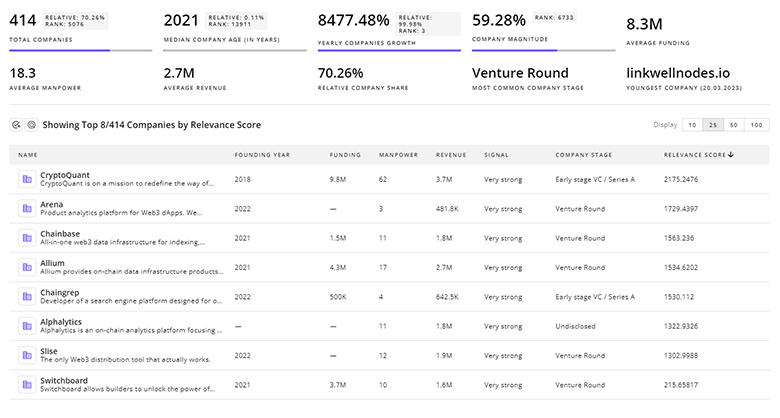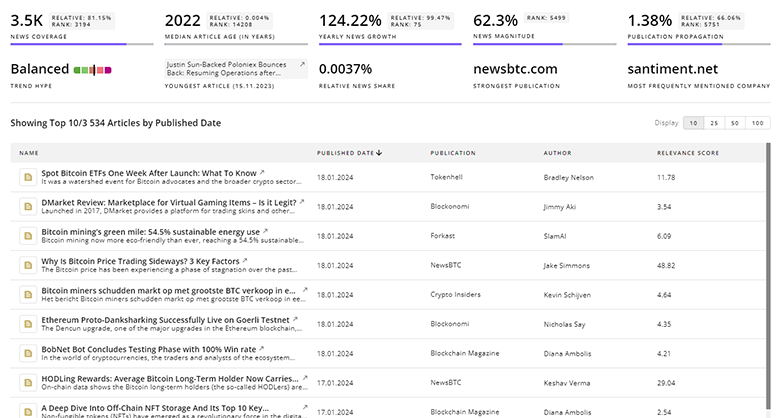
Biomaterials Report
: Analysis on the Market, Trends, and TechnologiesThe biomaterials sector is accelerating with clear commercial momentum: internal trend data projects an 11.2% compound annual growth rate and a 2030 market projection of 444,300,000 (internal reporting units) indicating solid midterm expansion in medical and sustainable applications. Growth is driven by polymeric biomaterials scaling into soft tissue and implant niches, continued revenue leadership by metallic implants in load-bearing use cases, and an expanding services layer (biocompatibility testing, scale-up testbeds) that forms the commercial on-ramp for advanced materials researchandmarkets – Biomaterials Market Share Analysis.
This report was last updated 31 days ago. Spot an error or missing detail? Help us fix it by getting in touch!
Topic Dominance Index of Biomaterials
To identify the Dominance Index of Biomaterials in the Trend and Technology ecosystem, we look at 3 different time series: the timeline of published articles, founded companies, and global search.
Key Activities and Applications
- Development of resorbable polymer scaffolds for orthopedics and tissue engineering — high R&D and regulatory intensity but large addressable demand in bone repair and spinal implants
- Manufacturing of metallic implants (titanium, cobalt-chrome) for load-bearing joint and dental devices — remains the largest revenue contributor in many market models and the reference performance baseline for new polymeric alternatives market_us - Biomaterials Market.
- Integrated drug-delivery biomatrices and growth-factor loaded scaffolds that combine structural support with localized therapy for faster healing and reduced systemic exposure alliedmarketresearch - Bioactive Materials Market.
- Additive manufacturing of patient-specific implants and scaffolds — 3D bioprinting and low-temperature polymer processing enable personalized geometries and embedded biologics for craniofacial and soft-tissue repair PrintBio, Inc..
- High-volume sustainable biomaterials produced from waste feedstocks (PHA, bacterial cellulose, mycelium) for packaging, construction, and consumer materials where regulatory burden is lower and scale economics are attainable BIOMAC.
Emergent Trends and Core Insights
- Polymeric segment expansion as the fastest technical growth vector: polymeric biomaterials capture accelerating R&D and commercial interest because they address soft-tissue and drug-elution niches with higher margin potential than commodity metals
- Regulatory and testing infrastructure acts as a market moat: service providers that deliver ISO 10993 / ISO 17025 / GLP testing and regulatory pathways shorten commercialization timelines and increase acquirability of technology platforms NABI, MDR Biotest.
- Feedstock arbitrage and circular inputs reduce unit costs: companies turning food and agricultural waste into PHAs, bacterial cellulose, or lignin derivatives capture immediate cost and ESG advantages versus synthetic-only approaches Biop Biotech.
- Engineered end-of-life and enzyme-enabled degradation: embedding controlled degradation triggers inside polymer matrices changes value capture across the lifecycle and reduces downstream disposal liabilities
- Platformization of biomanufacturing and democratization of biofabrication tools: desktop and handheld bioprinting systems plus no-code formulation toolchains compress R&D cycles and expand customer segments from elite labs to hospital-based device teams AdBioInk Biosystem Technology.
Technologies and Methodologies
- 3D/4D bioprinting and low-temperature polymer processing for embedding growth factors and cells in patient-matched geometries
- Controlled-porosity scaffold architectures and oriented pore channels to enable vascularization and nutrient transport in large-volume implants; design emphasis moved from porosity alone to perfusable, multi-scale networks
- Surface functionalization and nanotexturing to accelerate osseointegration and reduce infection risk; coatings carry growth factors or antimicrobial peptides for staged biological interaction [Patent & internal analysis summarized in the data].
- Enzyme stabilization and embedded-degradation systems to program end-of-life behavior for high-volume biomaterials without sacrificing recyclability or performance
- AI-driven formulation and predictive models to optimize material-cell interactions, reduce wet-lab iterations, and accelerate scale-up for complex bioinks and composite scaffolds Elytra Biomaterials.
Biomaterials Funding
A total of 1.2K Biomaterials companies have received funding.
Overall, Biomaterials companies have raised $43.3B.
Companies within the Biomaterials domain have secured capital from 4.9K funding rounds.
The chart shows the funding trendline of Biomaterials companies over the last 5 years
Biomaterials Companies
Materialize Bio
Materialize Bio develops biopolymer-based implants with scalable 3D manufacturing designed for high-volume surgical use cases, starting with drug-eluting ear tubes. The company leverages natural biopolymers and specialized low-temperature processing to preserve biologics and enable drug-elution features that metal implants cannot provide. Their platform targets both personalized and high-volume implant markets, aiming to reduce dependence on metal in selected indicationsBRINTER
BRINTER is a MedTech platform focused on 3D-bioprinted bio-synthetic implants for soft-tissue repair, launching first in rotator cuff/tendon repair. The firm combines proprietary printing hardware with application-specific bioinks to deliver implants intended for routine surgical workflows, positioning the company as a vertically integrated challenger in sports-medicine implants3DBioFibR Inc.
3DBioFibR scales production of collagen fibers via patented dry-spinning technology that produces high-strength collagen at commercial throughput. Their fibers serve as feedstock for bioprinting, hydrogels, and load-bearing scaffolds, addressing a manufacturing bottleneck for collagen-based implants and bioinksIntropic Materials
Intropic embeds stabilized enzymes into polymers to program controlled, rapid, and non-polluting degradation once materials reach composting or microbe-rich environments. The approach targets medical packaging, consumer plastics, and higher-value applications where controlled end-of-life behavior adds regulatory and commercial valueBiological Lattice Industries
BLI provides automated biofabrication hardware and Loominus Studio software that combine high-resolution 3D bioprinting with AI-guided workflows. Their ecosystem lowers the barrier to entry for tissue engineering R&D teams, shortening iteration cycles for new biomaterial formulations and accelerating technology transfer to clinical partners
Identify and analyze 5.3K innovators and key players in Biomaterials more easily with this feature.

5.3K Biomaterials Companies
Discover Biomaterials Companies, their Funding, Manpower, Revenues, Stages, and much more
Biomaterials Investors
TrendFeedr’s investors tool offers a detailed view of investment activities that align with specific trends and technologies. This tool features comprehensive data on 3.9K Biomaterials investors, funding rounds, and investment trends, providing an overview of market dynamics.

3.9K Biomaterials Investors
Discover Biomaterials Investors, Funding Rounds, Invested Amounts, and Funding Growth
Biomaterials News
Stay informed and ahead of the curve with TrendFeedr’s News feature, which provides access to 14.6K Biomaterials articles. The tool is tailored for professionals seeking to understand the historical trajectory and current momentum of changing market trends.

14.6K Biomaterials News Articles
Discover Latest Biomaterials Articles, News Magnitude, Publication Propagation, Yearly Growth, and Strongest Publications
Executive Summary
The biomaterials domain now separates into two durable commercial tracks. The first track focuses on clinical-grade regenerative implants and drug-eluting scaffolds, where certification, reproducible manufacturing, and clinical evidence create sustainable cash flows for platform players. The second track targets scale and feedstock efficiency, converting waste streams into competitive biopolymers for high-volume, lower-regulation markets. Strategic winners will be organizations that align technical superiority with either regulatory infrastructure or feedstock cost advantage. For investors and corporate strategists the immediate priorities are (1) secure regulatory and testing partnerships to compress time to market, (2) validate feedstock and end-of-life economics for any sustainability claims, and (3) invest in platform tools that digitize formulation and scale manufacturing — these moves convert technological novelty into defensible commercial value.
Interested in enhancing our coverage of trends and tech? We value insights from experts like you - reach out!












